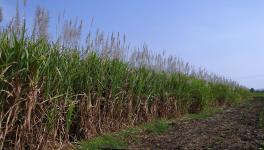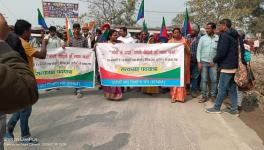As Excess Rain Destroys Kharif Harvest, Debt-Ridden UP Farmers Await Loss Compensation
Moradabad/Rampur/Bareilly/Pilibhit/Budaun (UP): As farmers in western and Terai regions of Uttar Pradesh are counting on the Rabi crop to recover the losses they suffered owing to the destruction of the previous season’s crops such as grains, mustard seeds, flowers and vegetables, the state government has not so far been able to complete the “survey” of the crop loss caused by incessant rains and subsequent floods — which almost completely destroyed the Kharif crops (especially paddy, bajra, mustard, chilly, etc) in the region.
Sharda, Ganga and Ramganga rivers, which enter UP from Uttarakhand, led to the flooding of several villages on its banks after water from Sharda Banbasa barrage and Kalagarh dam in Uttarakhand was released.
Shanti Gangwar, a resident of Gyanpur, Kanth, in Uttar Pradesh’s Moradabad district had cultivated flowers on one acre of land, but heavy rains and strong wind brought it down completely.
“As advised by the district administration, I registered the losses on toll-free numbers to get claims under the Pradhan Mantri Fasal Bima Yojna. I alternately also reached out to the tehsildar and sub-divisional magistrate to get the losses recorded. But forget about any compensation, no government official so far visited my field to carry out even a survey, which is prerequisite for any claim settlement,” she told NewsClick, adding that she is unable to repay Rs 2.5 lakh she had borrowed from a government bank.
The visibly upset woman said the crops are gone, and the loss is huge. “I have to take an additional sum from a private money lender to pay back the first loan amount and sow the next crop. There is neither any compensation nor a loan waiver. That is why farmers get trapped in the debt net. And when he tries to come out of it, he is left with the only option: commit suicide,” she added.
Baheri and Meerganj tehsils in Bareilly district were the worst hit where over 90% of the farmers either fully or partially lost their crop to the torrential rains and floods. As per an estimate, around 8,000 farmers across 250 villages lost their crops in the district.
Vijendra Singh, who belongs to Baraura village in Baheri tehsil of Bareilly district, owns 50 bighas (8.33 acre) of land. He had cultivated paddy on two acre. The flood destroyed over 70% of the crop, and he could harvest only 17 quintals. Since the yield was not meeting the quality parameters for the government procurement, he had to sell to a local trader at the rate of Rs 1,300 per quintal.
“I have a debt burden of Rs 1.5 lakh. Since I have not got any compensation from the government, I can think of partially repaying the loan only if the sugar mill clears the dues of sugarcane it had procured last year in the days to come. If this payment gets late, I won’t be able to do it as I also have to spend on sowing the next crops,” he said.
Naresh Gangwar belongs to Dhimri village in Nawabganj Tehsil of the district. He had cultivated paddy on his 2 of the total 10 acre of land. The rain and flood brought down the ready to harvest crop on one acre of land. “Only a survey has been done so far. I have not received a single penny as compensation,” he said.
“I have cultivated sugarcane on the rest eight-acre of land. The sugar mill is yet to clear my last year’s dues of Rs 2 lakh. I want to ask (Prime Minister) Modi and (Chief Minister) Yogi what happened to the promise of making payments to farmers within 14 days of the procurement. Also what happened to the claim with regards to increasing the farmers’ income by two-fold. Instead of doubling, our income has been reduced by half,” added the visibly angry farmer.
Govinder Singh of Jamalpur village in Bareilly’s Baheri tehsil had cultivated paddy on his entire 25 acre of land. He lost the crop on 12 acre by the floodwater. He harvested 200 quintals of paddy, which was sold to local traders for Rs 800 and Rs 1,300 per quintal, depending on the quality of the yield.
“Had there been no floods, the return would have been at least Rs 10 lakh,” he said, adding that he has borrowed Rs 3 lakh from Kisan Credit Card. “I don’t know how will I return it,” he said in despair.
Gaurav Singh of Punai village in Bareilly’s Baheri tehsil was extremely angry with the government in the state and the Centre. The paddy crop he had cultivated on 4 of the 10-acre of land he owns was completely destroyed. On the rest six acre, he has cultivated sugarcane. He will get its payment next year. The local sugar mill has to clear his last year’s dues to the tune of Rs 1 lakh as well.
“We are asking the government to give us minimum support price of our product, not the maximum price. In every field, the manufacturer decides the cost of his product. But farmers don’t have that privilege. The government decides the rate of agricultural produce. When people sleep in their cosy rooms in the winter, we remain in our fields to irrigate the crops. No one can even dare to enter our sugarcane fields at night, fearing possible harm inflicted by insects and deadly reptiles. But we go there putting our lives at stake.”
“After harvesting the crops, we run from pillar to post for procurement but the government refuses to buy it. Left with no option, we have to sell to private traders at lower prices just to recover the input cost and a small amount of profit. After reaping sugarcane, we wait for our turns for hours outside sugar mills. Sometimes, we sleep under the trolleys of our tractors outside the mills. But the payment is made after a year. If the crops are destroyed, there is no compensation. And then the governments shamelessly make tall claims regarding the upliftment of farmers,” he added.
The state government has announced to give assistance amounting to about Rs 13,500 on two hectares of land. “After the damage report is received from the tehsils, it will be uploaded on the disaster relief website. It will be followed allocation of funds to the affected farmers,” an official in the district collectorate, refusing to be named, told NewsClick.
As per the information received by us, so far, he said, crops on around 5,052 hectares have been destroyed and over 4 lakh people have been affected. “Survey work is still going on in affected tehsils,” he added.
People in the knowhow of the recent developments said that the government may announce a relief package for the affected farmers once it receives the estimates of crop losses from districts post-survey being conducted by agriculture and revenue department officials.
“Apart from many vegetables, the groundnut and paddy crops were ready for harvesting, but the extended monsoon downpour and floods washed out the crops in most of the districts in September and October and floods in the Terai and the eastern regions of the state,” a senior official said.
The government, he said, is faced with a challenge to compensate farmers liberally by not only giving them cash but also other concessions such as loan waivers, land revenue and electricity bills waivers.
Additional chief secretary (Agriculture) Devesh Chaturvedi said assessments of crop damages are being made by revenue and agriculture department officials in the affected districts of the state.
“We expect to receive their reports very soon. Once it is done, the revenue department will compensate the affected farmers while the agriculture department will compensate farmers covered under the crop insurance scheme,” he said, adding that about 25 lakh farmers were insured for the Kharif season.
However, all affected farmers may not get compensation from the government because many of them may not qualify for relief under the norms.
“The damage due to a natural disaster should be over 33% of the crop to get compensation from the government. The damage assessed to be below that will be compensated for as per the Centre’s existing guidelines. But the state government can find ways if it really wants to help the affected farmers. It can afford the expenditure from its own resources,” said an official associated with the revenue department.
Get the latest reports & analysis with people's perspective on Protests, movements & deep analytical videos, discussions of the current affairs in your Telegram app. Subscribe to NewsClick's Telegram channel & get Real-Time updates on stories, as they get published on our website.
























